Ijraset Journal For Research in Applied Science and Engineering Technology
- Home / Ijraset
- On This Page
- Abstract
- Introduction
- Conclusion
- References
- Copyright
Home Automation using IoT
Authors: Anjali Kalwar, Yashika Sinha, Payal Samanta
DOI Link: https://doi.org/10.22214/ijraset.2022.41777
Certificate: View Certificate
Abstract
This paper aims to present a home automation system based on IoT using the ESP8266 built-in Node MCU. IoT and Wireless systems have a rising peak in the contribution of automating our daily life devices and stepping towards a better and more comfortable future. This project describes details of the utilization of this technology to automate home appliances. Hence for the purpose, NodeMCU (ESP8266) microcontroller is utilized with the Relays to control the switching of appliances remotely from the server.
Introduction
I. INTRODUCTION
The Internet of Things (IoT) describes physical objects (or groups of such objects), that are embedded with sensors, processing ability, software, and other technologies, and that connect and exchange data with other devices and systems over the Internet or other communications networks.
A smart home is defined as a home equipped with lighting, heating, and electronic devices that can be controlled remotely by smartphone or computer.
In our project, we are trying to control some home appliances using ESP8266(Node MCU) along with some relays and motor drivers. We can control the devices wirelessly from anywhere using a normal web server and Wi-Fi technology.
We also control all the direct network-connected as well as mutually connected devices from almost anywhere around the world.
As India is a developing country, stepping forward in automation with one of our topmost advanced technologies of IoT (that uses servers and the internet to control electronic devices), our objective is to build home automation using IoT that can be affordable to the people.
The objectives of our project are
- Control Over home Appliances using a Website and Switches: This project controls home appliances like fans, lights, water planting systems, and automatic curtain openers.
- A website with Basic Information: Our website will be developed with HTML, CSS, and JAVASCRIPT. The website will display basic information like date, time, and weather.
- Controlling the home Appliances from Anywhere: Through our user interface (website) the user will be able to control his/her home appliances from home as well as from any other place than home.
- Conserve Energy Resources: Due to any emergencies, mishandlings, or loads of work or pressure if any electronic device is left working it could lead to waste of our energy resources. But as our devices are monitored by the user from anywhere, this can be avoided which will help the user to reduce its electricity bills, and it will help in avoiding unnecessary fuss or accidents that could happen.
- Developing our Server and Website: We will develop our website with the help of HTML(Hyper Text Markup Language) and make it more user-friendly by using CSS( Cascading Style Sheets). Further, we develop the backend and server of the website using PHP(Hyper Text Preprocessor), SQL(Structured Query Language), and many other languages.
- Making The Project At The Lowest Cost From Market Price: As our project controls basic appliances we will not need smart devices and compatibility will not be a problem decreasing the price of making as well as installing our project in homes.
II. METHODOLOGIES
Many home devices now have WiFi and can interact with other home devices, smartphone applications, and home computers. An issue is that these devices cannot communicate with each other or require an additional device to do so and need an individual application on the smartphone to be controlled. A much better option is to unify these devices into one program/device that controls them.
A. Selection Of Implementation Platform
As there are many platforms over which a home automation system can be implemented of the currently available platforms -ESP8266, WiFi, Arduino, powerline, Bluetooth was found on which we can implement home automation systems. We are using Esp8266 over Arduino as in Arduino we have to install wifi module externally while in ESP8266 wifi module is pre-installed and instead of Bluetooth module, we are using wifi as in Bluetooth the range of the network is less while in wifi it has wide range. These platforms were found most appropriate due to their low cost availability , reliability, and simplicity when used for individual control home automation systems which our project work is on .
- Through Bluetooth Network: In this technology we make use of an Arduino Bluetooth board. The electronic devices are connected to the I/O ports of the bluetooth module with the help of relays. An interactive software program is needed to provide a user interface.
- Through Wifi Network: It consists of three main modules- the server, the hardware interface and the software. The appliances are connected to the Node MCU I/O ports using relays. These hardwares can be interfaced with the software and hence can be controlled using mobile phones.
- Through Zigbee Network: The system consists of a PIC microcontroller and Voice Recognition system. The voice commands are transmitted to the zigbee module using the PIC microcontroller.Zigbee receiver unit has another PIC Which is used to process the commands. The devices which have to be interfaced are connected to the zigbee module using relays.
|
System |
Initial Communication |
Access from |
Cost |
Speed |
|
Bluetooth |
Bluetooth and AT command |
Within 10 meters |
low |
Fast speed due to proximity
|
|
Wireless Fidelity |
Infrared, Radio waves |
Varies accordingly to using waves |
high |
Slow speed |
|
ZigBee |
ZigBee and AT command |
Within 10 meters |
low |
Fast speed |
B. Justification for using Node MCU compared to Arduino UNO
- Architecture Based Difference: Node MCU (ESP8266) is a microcontroller with a built-in wifi capability whereas Arduino UNO microcontroller lacks a built-in Wifi module.
- Operating Voltage: The boards based on the ESP will have a longer operation time because these boards could operate under 4 V although at 4 V the Arduino boards have been shut down.
- Current Consumption: The current consumption is significant for battery-based projects to increase the lifetime of the project As Node MCU has low power consumption in comparison to Arduino, it is more preferred to be used in Battery based projects. Hence, for developing the actual project, priorities are given to low-cost availability, reliability, flexibility, and simplicity. Therefore, Node MCU(ESP8266) which has Wifi capability is utilized. This project includes development of software interface with backend.
III. DISCUSSION
This project consists of switching on/off home appliances.
The below discussion will elaborate the hardware based system with the help of block diagram, circuit diagram, hardware components (with specifications), PCB designing and explains the basic software language requirements for developing software interface and maintaining the backend.
- Block Diagram: Fig1 is the general block diagram of the project. The figure describes that the project controls the switching of home appliances like Light(Bulb) , Fan , Curtains and Plant system. The user can control the devices via a website from anywhere in the world. Also, the project consists of switching of home appliances manually via switches as a backup for unexpected conditions like not working of Node-MCU, core rupture, etc.

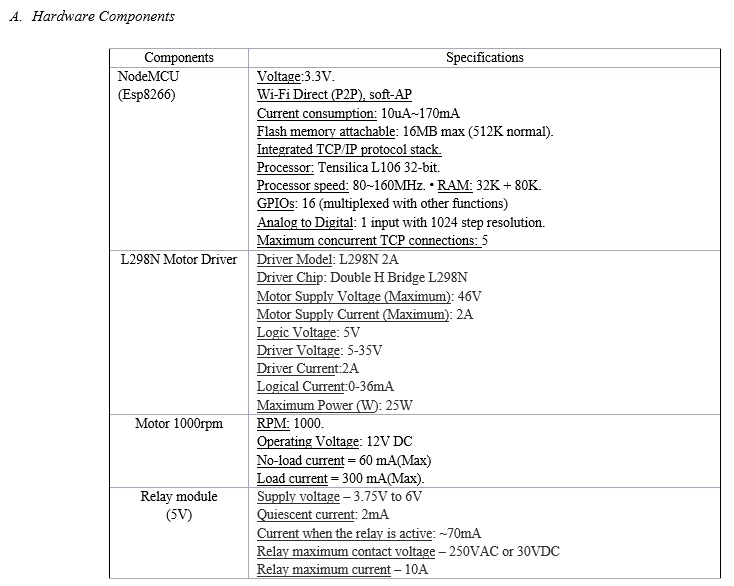
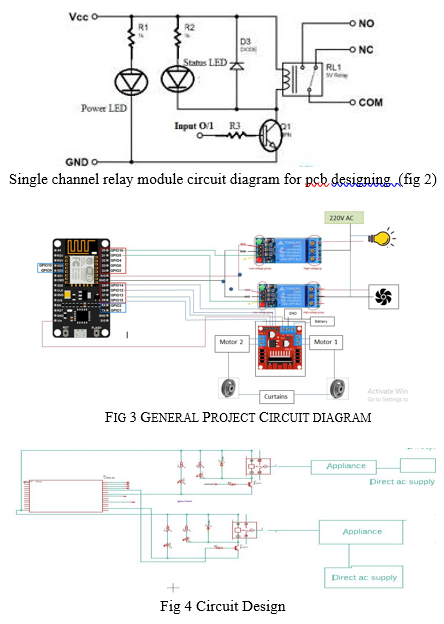
Fig 2 represents the circuit diagram for the relay module that is utilized in the final project circuit diagram. The relay circuit diagram consists of a npn transistor BC547 and a flyback diode 1N4007 inclusive of power and status LED. The relay attached in the final project is of 5V.The circuit consists of all three resistors of 1k ohm..
Fig 3 represents the overall circuit diagram using relay modules. All the relay modules will be replaced with the circuit diagram from fig 2.
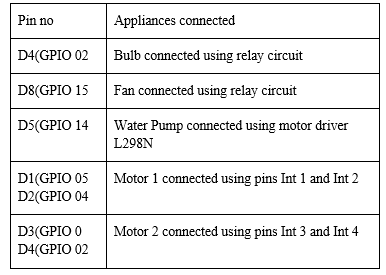
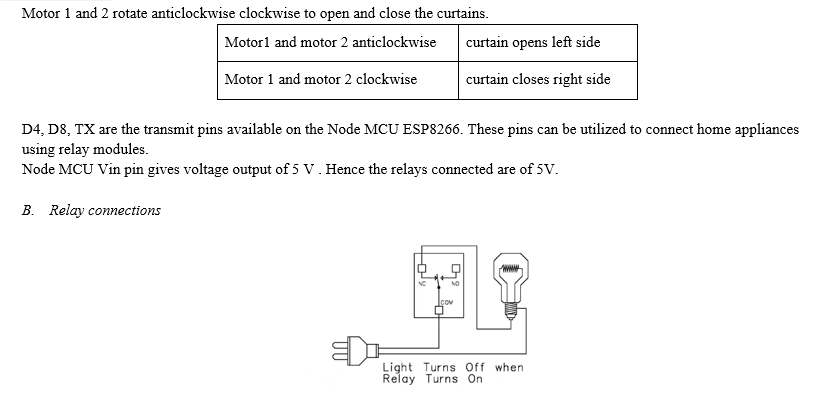
On the input side, a logic signal is received from Node MCU and other pins connected are Vin and Gnd.
On the output side, home appliances are connected with plugs. Gnd of plug is connected to the common pin of the relay. The plug and bulb are connected directly through a wire. A wire from normally open in is connected to the bulb. As the wire is connected to a normally open pin , the bulb turns on when the relay turns on. Hence initially the bulb remains off. It only gets triggered when the relay is triggered.
C. Software Specification and Details
Platforms utilized in this project for software -
- Visual Studios: It is used to develop computer programs, as well as websites, web apps, web services and mobile apps.
- XAMPP: XAMPP is an abbreviation for cross-platform, Apache, MySQL, PHP and Perl, and it allows you to build WordPress sites offline, on a local web server on your computer.
- 000webhost: Free Web Hosting site with PHP, MySQL, free Website Builder, cPanel.
- Website Interface: For developing the user interface, basic HTML and CSS language are utilized. HTML is used for giving the bone structure to the website whereas CSS adds more colors and graphics to the website appearance. Also, basic Javascript is used to add everyday information to the website like Time, Weather and Date.
- HTML: The Hyper Text Markup Language or HTML is the standard markup language for documents designed to be displayed in a web browser.
- CSS: Cascading Style Sheets is a style sheet language used for describing the presentation of a document written in a markup language such as HTML.
- JAVASCRIPT: JavaScript is a dynamic programming language that's used for web development. It allows you to implement dynamic features on web pages that cannot be done with only HTML and CSS.
D. Website Backend
PHP- PHP is a server side scripting language that is embedded in HTML. It is used to manage dynamic content, databases, session tracking, and even build entire e-commerce sites. In this project we have used php for creating a server for the user so that when the user login to the website , the user should be able to access the system and if the user is not logged in then the access is denied .
MySQL- MySQL is an open-source relational database management system. As with other relational databases, MySQL stores data in tables made up of rows and columns. MySQL database will store the user login credential and appliance status . If the login credentials do not match to the database then the access is denied . The user would not be able to use the system .
E. Overall Working of the Project
Our website has 4 Api codes i.e read_all.php,update.php,db_connect.php,dbread.php.
read_all.php - This page will read the data received from the user interface which will be further sent to the nodemcu and connect with the db_connect.php.
db_connect.php - This page connects the nodemcu with the database .
update.php - This page updates the value in the database after every operation like on/off of appliances .
dbread.php - It connects all the webpages to the database .
We have 2 tables in the database , one for login user information and for appliance status .
First the user will login through our website .After successfully logging in , the user will be directed to the home page where there are different sections of room available .In each section there are options for appliances. Suppose the user wants to control the light of the kitchen he/she will select the kitchen option followed by light page .In the light section there is on off button .As the user switches through the on off button, the status of the appliances will be updated simultaneously in the database where further the database is connected to Node MCU via Arduino code and wifi. Hence, in this way users can control the appliances through the website.
IV. RESULTS
A. Hardware Outputs
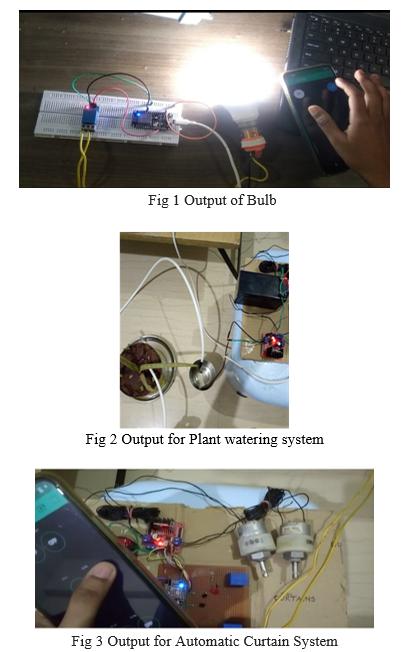
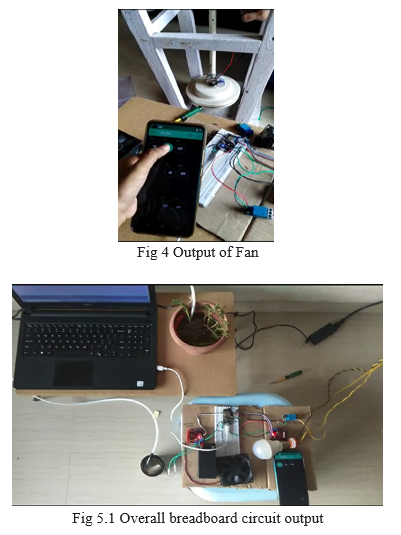
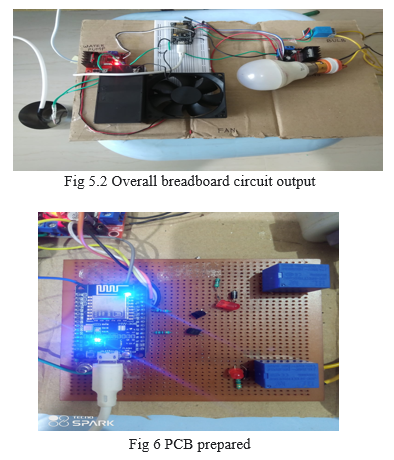
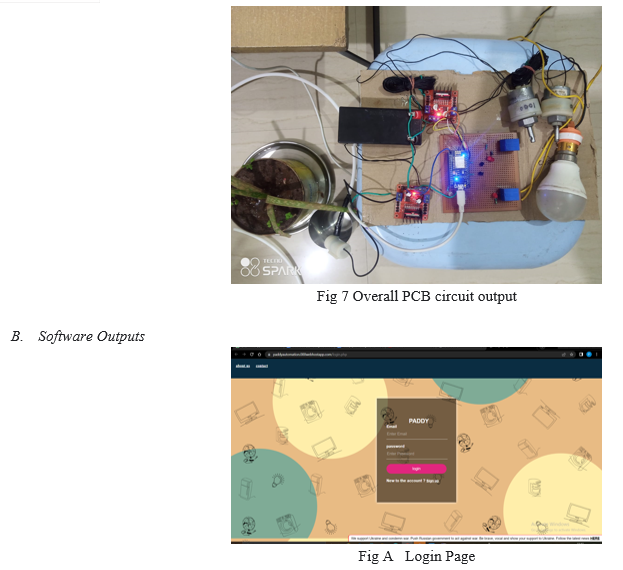
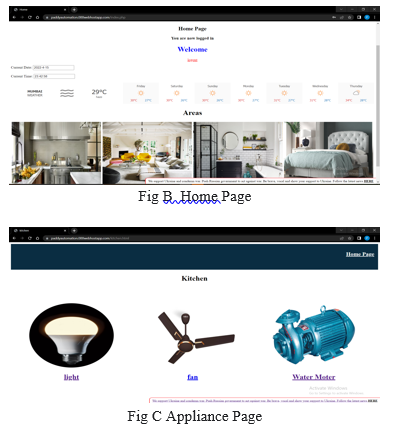

Above figures are the results obtained in the project.
As we control daily and frequently used home appliances, and the project overall costs comparatively less, it can be used not only in modernizing private sectors but its benefits can also be obtained in commercial fields by installing it in companies. As our project consists of 12V battery, it needs to be recharged from time to time. Further scope of development of the project can be connecting other major devices like AC, TV, printers etc to Node MCU and following the required changes on the website and server. Also, cameras and safety door systems can be developed and home security and safety issues will be solved. Also on a software basis, our server can be connected to other servers to obtain basic information about traveling, and other basic systems like reminders/sticky notes can be added to the website.
Conclusion
In this paper we have presented the concept of a Home Automation system using IoT. The hardware components such as Node MCU, relays and motor drivers and other products available in the market have been reviewed. We also discussed the specification of Node MCU and the general system architecture of both hardware and software systems. Utilizing this project will help you to control switching of home appliances from anywhere in the world. Also the project is inclusive of the manual switches which makes it ready to face any unexpected problem that may be caused due to the Node MCU microcontroller. This project can further be improved by adding more home appliances like music system and also making it more flexible by improvising its hardware and not only controlling the switching of the devices but also their regulation speed. Our project has tried to overcome the limitation of WiFi presence at all times as it also has the manual switches attached to it.
References
[1] WebsiteCodefor our project https://drive.google.com/drive/folders/1S61xDzPw9RFDeV50pHhRiGjSurDpc5ga?usp=sharing [2] Literature survey reference papers https://www.entrepreneur.com/article/362497 https://ijsrcseit.com/paper/CSEIT1833142.pdf [3] NodeMCU Datasheet https://www.espressif.com/sites/default/files/documentation/0a-esp8266ex_datasheet_en.pdf [4] Other links https://iotmonk.com/lessons/creating-iot-cloud-scratch-using-php-mysql-esp12e-part-1/
Copyright
Copyright © 2022 Anjali Kalwar, Yashika Sinha, Payal Samanta. This is an open access article distributed under the Creative Commons Attribution License, which permits unrestricted use, distribution, and reproduction in any medium, provided the original work is properly cited.

Download Paper
Paper Id : IJRASET41777
Publish Date : 2022-04-23
ISSN : 2321-9653
Publisher Name : IJRASET
DOI Link : Click Here
 Submit Paper Online
Submit Paper Online

